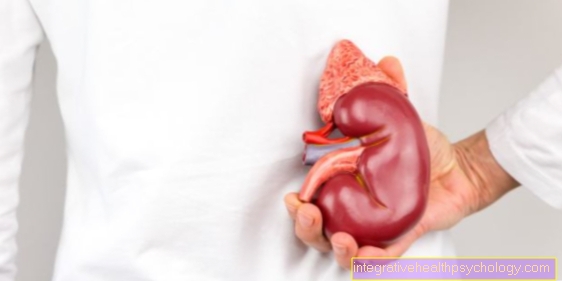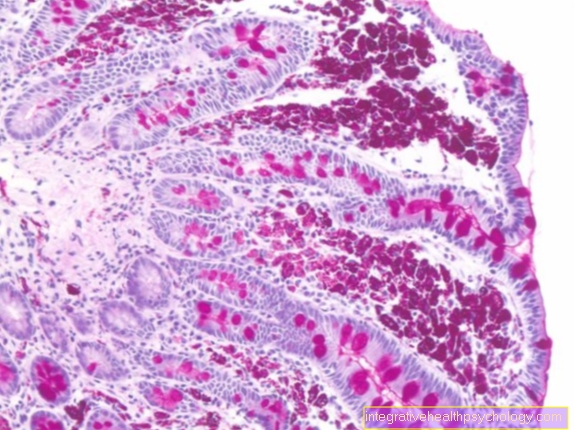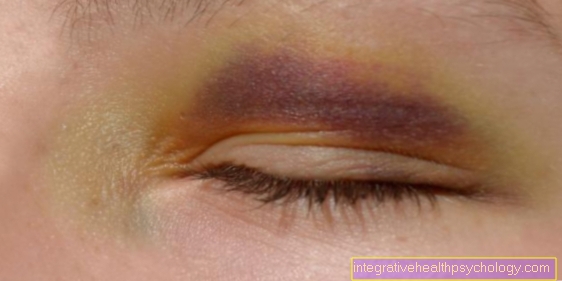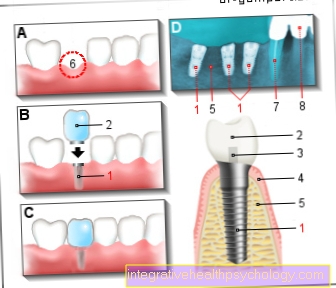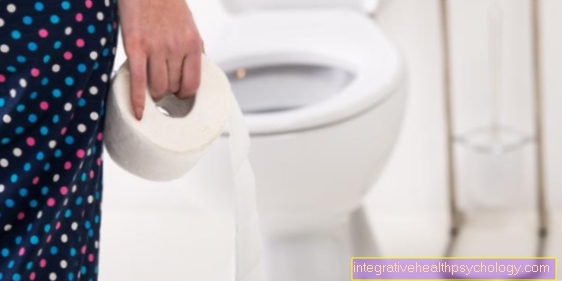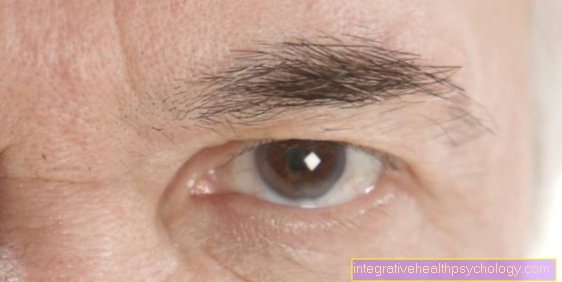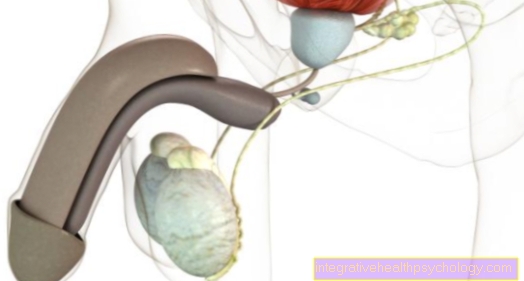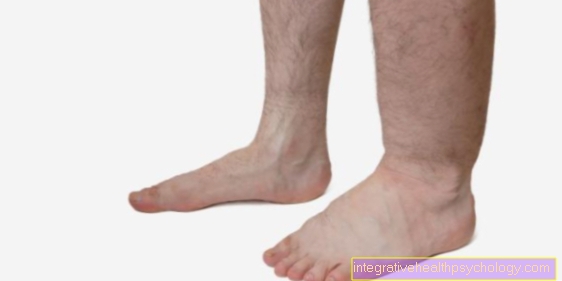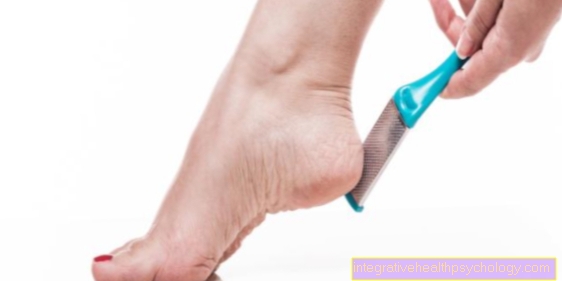Boils on the labia
definition
A boil on the labia is a bacterial inflammation of a hair follicle in the female genital area. Since the genital area provides a good breeding ground for bacteria due to its warm, moist, hairy environment, this area of the body is an exposed area for the development of a boil. In medical terminology, one speaks of a predilection point. A boil on the labia shows up as a heated, reddened, painful lump. In most cases, the neighboring tissue is also affected. When several boils form next to each other on the labia and fuse with each other, this skin phenomenon is called carbuncle. If boils appear frequently on the labia, one speaks in technical jargon of a furunculosis. In this case, a doctor should clarify the cause.

Causes of boils on the labia
There are various causes for the development of boils on the labia. The risk increases when several risk factors occur in combination. The prerequisite for the development of a boil on the labia are injuries in the hairy genital area. These injuries can be visible or very tiny and inconspicuous. Bacteria can enter these areas. It is usually staphylococci that cause the bacterial inflammation. Most often it is the Staphylococcus aureus. Many staphylococci are part of the physiological skin flora and have no fundamental disease value. But under certain conditions - favorable for the bacteria - they can multiply and trigger inflammatory processes.
The bacteria get under the skin via a hair follicle at an injured skin area. Finally, within a few hours or days, an inflammatory, deep infiltration develops. After a few days or a week, the boil on the labia usually bursts on its own. This allows the pus to escape and the boil to heal. Usually a small irreversible scar remains. The injuries to the labia can result from poorly fitting underwear, for example. Boils are also common after shaving. In addition, dry and previously damaged skin can lead to injuries. Increased sweating and friction can also irritate and damage the skin in the genital area. The risk of boils on the labia is greater with a weakened immune system and certain diseases, such as diabetes mellitus.
Further causes and more detailed information can be found on our website Causes of Boils
diagnosis
Appropriate questioning of the patient is essential to diagnose a boil on the labia. Since talking about illnesses or problems in the genital area is often associated with shame, the questions are not always answered honestly. However, this makes it difficult to find the cause and the associated treatment that is as adequate as possible. Therefore, it should be made aware that the doctor has a duty of confidentiality and that the well-being of the patient is his priority. After the questioning, the so-called anamnesis, the doctor will look at the affected area and feel it. In addition, the doctor examines the general skin status and appearance of the patient in order to identify possible causes. If possible, a smear will be taken to identify the bacterial pathogen. If boils occur frequently, the blood sugar is measured. In some cases, taking additional blood tests can be useful.
Which doctor should I see?
As a rule, it makes sense to see a gynecologist if you have a boil on the labia. If there are other accompanying complaints or another underlying illness, further examinations and treatments by another specialist may be helpful.
Symptoms of a boil on the labia
As a rule, boils appear on the labia with the typical signs of inflammation. These include warming, redness, swelling, and pain. The individual complaints can vary in severity. Often the boil can be felt as a pressure-sensitive and elastic knot. Underwear and movements can cause friction and increase pain. Most of the time you can see a hair in the center of the boil, the follicle of which the bacteria have penetrated. When the boil bursts, pus can escape. This is usually yellowish and can sometimes smell unpleasant. The symptoms associated with a boil on the labia are uncomfortable, annoying and sometimes very painful, but usually harmless.
A general feeling of illness, fever, chills, fatigue and other flu-like symptoms can only occur in unfavorable conditions, with a weakened body's own immune system. If a fever is detected, this is a warning sign and shows that the bacteria have entered the blood. This means that there is a risk that blood poisoning can develop. In these cases, medical help must be sought. Usually, labia boils are less likely to cause complications. But when these occur, rapid and appropriate medical action is required. If there are complications and circulatory failure, drowsiness and shock, an emergency doctor must be contacted immediately.
Lymph node involvement in a boil on the labia
If the boil was caused by an illness in combination with immunodeficiency, the lymph nodes may be painful or painless swollen. In these cases a doctor should be consulted. A comprehensive diagnosis must be carried out.
Boils on the outer labia
A boil, which is located on the outside of the outer labia, is often the result of a hairy area. Since it is located on the outside, it can be treated better on the one hand. On the other hand, an external point is exposed to contact with clothing and other external influences that can delay the healing process.
Boils on the inner labia
A boil inside the female genital area is often not the result of the “classic” route. Often their development is related to extra sebum glands found in unusual places on the body. These include the Fordyce glands. These glands were named after an American dermatologist. Among other things, they are localized in the female genital area. The Fordyce glands are seen as free sebum glands. Usually and in a healthy state, they do not cause any difficulties. Dysregulation can only occur under unfavorable conditions, which can lead to disorders and diseases. If there is a small injury or damage to the inner skin of the labia, bacteria can penetrate and cause inflammation. This can, among other things, imply the development of a boil on the inner labia.
Should I express the boil on the labia?
In no case should you try to express the boil on the labia. If possible, this should not be touched at all. Attempting to squeeze out the boil can make the inflammation worse and worse. In some cases, independent manipulation can lead to unpredictable, reversible and irreversible damage and complications.
Treatment of a boil on the labia
The treatment of a boil on the labia depends on the size and on individual factors.
Therapy is based on adequate hygiene of the genital area. If a boil has developed in this area, it should be exposed to as few chemical, mechanical or physical stimuli and noxa as possible.
Clean, warm, damp compresses can help break up the boil and the associated evacuation of the pus. By emptying the pus, the boil is relieved and can heal. If the pus cannot escape, a minor surgical procedure may be necessary. In these cases, a doctor will need to make a stab incision. That means he has to open the boil. This opening is often possible under local anesthesia. Usually it is a small and straightforward operation. The doctor will cut the boil with a scalpel so that pus can evacuate. The opening of the boil on the labia rarely has to be performed under general anesthesia. Should this be necessary, the patient will be informed verbally and in writing about the anesthesia. After the procedure, there is a follow-up treatment with antibiotic and antiseptic ointments. Instructions are given on how the patient should best care for and protect the wound.
Once the bacteria have entered the blood and lymphatic systems, antibiotics in tablet form or as an infusion may be necessary. In the case of recurring boils on the labia, the cause or underlying disease must be found out and treated. Often times, antibiotics such as clindamycin and rifampicin are used for 2-3 weeks. If there is an immunodeficiency, this must be treated accordingly. Vitamin C, among other things, is often used in this context.
You can find more on this topic on our website Treatment of boils
Pull ointment
For smaller, not yet melted boils on the labia, antibiotic and antiseptic ointments can contribute to the healing process. Pull ointments have a pain-relieving, antipruritic, blood circulation-promoting and sebum-reducing property. You can pull the pus out of the boil. This relieves the pus accumulation and the affected area of skin can heal. The pull ointments are mostly made from oil shale and, more rarely, on a vegetable basis. The ointments that are used in human medicine mostly contain ammonium bituminosulfonate. The use of these ointments should always be discussed with a doctor.
If the labia boil is larger, does not empty despite the ointment, there is an immunodeficiency or unfavorable conditions, the treatment of a labia boil with a pulling ointment may not be successful. In these cases, other measures are required. In addition, it should be ensured that there are no allergies or intolerances to the ingredients of the ointments. If allergic reactions are triggered, the ointment must be discontinued immediately. In these cases it is advisable to seek advice from a doctor.
You can find more information on this on our website Treatment of a boil with ointment
Home remedies
As a general rule, the body and its immune system have to perform well with every inflammation and therefore need support through a healthy lifestyle. A balanced diet rich in vitamins and nutrients, a balance between activity, exercise, rest, relaxation, pleasant thoughts and fresh air can help.
In addition, some authors recommend various teas and foods that they say particularly strengthen the immune system. Accordingly, regular drinking of nettle tea, for example, should strengthen the immune system. You should also ensure that you have adequate vitamin D and iron levels.
Some authors recommend using curd compresses for a boil on the labia. Some chilled low-fat quark should be placed in a thin, clean, small cloth and placed on the affected area.When the curd has become warm, the envelope should be renewed. If well tolerated, this can be repeated several times a day. In addition, a withered, slightly warmed white cabbage leaf can sometimes have a supportive effect on the affected area. This procedure can also be repeated several times a day if tolerated.
Compresses with chamomile and yarrow can also be soothing. For the chamomile compress, about a tablespoon of dried chamomile flowers is poured over 250 ml of boiling water. The tea should steep for 5-10 minutes and then you should strain it. A sterile compress is then soaked in it and placed on the affected area. The temperature on the back of the hand should be carefully tested beforehand to avoid burns. For a yarrow compress, pour 250 ml of hot water over a tablespoon of yarrow herb. Then let the tea steep for 10 minutes covered. The herb is then sieved off. A sterile compress is dipped in and using the same principles as the chamomile compress. In both cases, appropriate tea bags can also be used to make the tea.
Of course, all these home remedies should only be used on the outside of the labia and not on the inner genital area. At best, the measures are discussed beforehand with the doctor. In some cases, those affected find the use of Schüssler salts to be supportive. Various salts are used here. For example, the Schüssler salt No. 1 Calcium fluoratum in the potency D12. But also the salt No. 11 Silicea and the salt No. 12 Calcium sulfuricum are used to treat a labia furuncle. Both are usually recommended in a 6 D potency. Note, however, that calcium sulfurium is only used when the boil has already burst and pus is flowing out. Externally, ointments based on Schuessler salts No. 1 and No. 11 are sometimes recommended.
homeopathy
In the case of a boil on the labia, homeopathic remedies can have a supportive effect in some cases. Depending on the symptoms and individual factors, different active ingredients are recommended in different potencies. The application and dosage should be discussed with a doctor. Myristica sebifera is often recommended for skin inflammation, including a boil on the labia. Hepar sulfuris can have a supportive effect in the case of sharp pain. If the accumulation of pus persists and / or is difficult to heal, Silicea can be helpful. The German Central Association of Homeopathic Doctors (DZVhÄ) recommends a potency of C12 for self-treatment of all active ingredients. As a rule, 2 - 3 globules should be taken up to 4 times a day. They should not be chewed or swallowed directly, but should be allowed to dissolve on the tongue or in the mouth. At best, nothing should be eaten or drunk 15 minutes before and after taking the globules.
Duration
The duration of a boil on the labia depends on the immune system, size and individual components. With good hygiene, a good immune system, favorable conditions, and a relatively small size, there is a high chance that a boil on the labia will heal after a few days. This usually leaves a small, often inconspicuous scar.
Under unfavorable circumstances and a weakened body's own immune system, the healing process can take a few weeks. If complications arise, a labia boil can take months to heal.
Also read the article: The duration of a boil.
Boils on the labia during pregnancy
Since hormonal changes occur during pregnancy, this can provoke a boil on the labia. This can be explained by the fact that the hormones have an effect on the state of the skin. A change in the composition and balance of hormones can affect the appearance of the skin. This can result in the skin in the genital area becoming drier or more unstable and consequently increasing the risk of injury. Accordingly, the risk of the possibility of entry ports for bacteria increases. The result can be a boil on the labia.
In addition, the body's own defense system can change during pregnancy, making it more susceptible to bacterial infections. In addition, weight gain during pregnancy can lead to increased sweating and friction in the genital area. This can cause inconspicuous damage to the skin of the labia and cause a "boil". If a boil develops on the labia during pregnancy, a gynecologist should be informed as soon as possible. He can assess and decide which measures are expedient in terms of weighing up the benefit-harm ratio.


